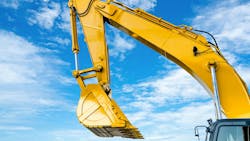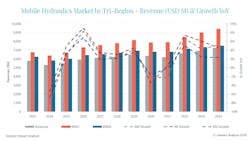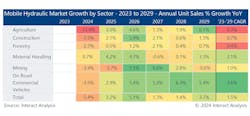A Return to Growth for Mobile Hydraulics in 2025
The mobile hydraulics market is expected improve in 2025 as interest rates decrease, helping to improve machinery demand.
A new study from market intelligence firm Interact Analysis is projecting the global mobile hydraulics market will contract 6.7% in 2024. But it views 2024 as a turning point for the sector and anticipates a return to growth in 2025.
Many economists are forecasting better economic conditions in 2025 and beyond as interest rates are lowered. This is expected to help improve demand for mobile equipment such as construction, agricultural and forestry machinery, as well as the hydraulic components and systems which power them.
The Factors Contributing to a Slower 2024
Interact Analysis is forecasting the mobile hydraulics market to reach a value of $17.5 billion in 2024, down from the $18.8 billion it achieved in 2023. High interest rates and inventory levels as well as geopolitical tensions are key drivers for the market’s current down cycle.
Like many other sectors, mobile hydraulics experienced strong growth in 2021 and 2022 as markets rebounded from the COVID-19 pandemic. After working through the many supply chain issues this caused because demand picked up again so quickly, many manufacturers are now in a destocking period to work through current inventory. Because of this, demand for hydraulics began to slow in 2023 and has continued that trend into 2024.
In conjunction with this, high interest rates have lowered demand for new or leased machinery and thus are making it difficult for OEMs to work through their inventory. On September 18, the U.S. Federal Reserve announced its first rate cut. It is expected to make further rate cuts in the coming months which Interact Analysis believes could help kickstart a new cycle of growth for the mobile hydraulics sector.
Eric Alström, President of Danfoss Power Solutions, said in an interview with Power & Motion the lowering of interest rates will help the hydraulics market to some extent. But it will also be necessary for OEMs and dealers to build their inventories back down which could cause the market’s current down cycle to linger depending on how long that takes.
Alstrom noted lower crop prices are negatively impacting demand for tractors and other agricultural equipment as well. He said prices have been low or wildly fluctuating, affecting farmers’ income and making them more hesitant to invest in new machinery.
The Association of Equipment Manufacturers’ (AEM) Ag Tractor and Combine reports for the U.S. and Canada have reflected the lower demand in this sector in 2024. While sales in certain segments have fared better than others, total tractor sales have been down from 2023 levels for much of the year. AEM’s most recent report for September shows total U.S. Ag tractor sales decreased 19.2% and combine sales were down 40.7% from the previous year. It was a similar situation in Canada with total tractor sales falling 24.9% and those for combines 51.9%.
Interact Analysis’ data also shows a strong decline for the global agricultural equipment market, projected to be down 13.9% in 2024 (see Figure 2 below). In addition, it says the global construction sector is performing poorly and dragging down the overall market in the Americas, which represents 46.5% of the region’s mobile hydraulics revenue.
Read More Economic Trend Data for the Fluid Power Industry
Downward Trend Continues for Fluid Power Shipments in August 2024
Fluid Power Industry on Downward Trend Before Recovery in 2025
2024 Recession Presents Fluid Power Industry Opportunities for Investment
You can also visit our State of the Industry page for even more technology and economic market trend information.
Meanwhile, the economic challenges in Europe are causing declines in all machinery sectors. The higher energy costs associated with the war in Ukraine and de-coupling of Europe from Russian natural gas are contributing to these challenges according to Interact Analysis.
Asia-Pacific, on the other hand, is expected to achieve the highest compound annual growth rate (CAGR) in 2024 due to strong demand in the region from the material handling and mining sectors.
Blake Griffin, Research Manager at Interact Analysis, said in the market firm’s press release announcing the new study that while the current decline of the mobile hydraulics sector is unfortunate, they are not uncommon as it is a cyclical market. “A typical cycle will see growth peaking and troughing every 3-5 years. The last peak was 2021, where growth was in the double digits. This growth has slowed since then and we expect 2024 to represent the trough of the current cycle, with growth returning in 2025,” he said.
Improving Market Conditions to Benefit Mobile Hydraulics in 2025
Interact Analysis is projecting sales growth for all of the mobile machinery markets served by hydraulics in 2025 (see Figure 2 below).
Griffin told Power & Motion there are several factors at play which will enable a return to growth in 2025. These include softening of interest rates coupled with the resolution of the U.S. general election.
“We find the market typically performs worse during election years due to the uncertainty it causes to the future of the market,” he explained. “With this resolving, coupled with the reduction of interest rates both in the U.S. and abroad, we expect conditions to be improving in capital equipment markets.
“Further, we expect the de-stocking period which has been present for the last 12-18 months to be resolved. This began occurring after the boom in demand experienced in 2021/2022. As customer inventories wind down, we expect new orders to pick up again,” he said.
Griffin said the material handling equipment market has been a bright spot in a down market and is expected to remain a high growth area for mobile hydraulics. Many of the capital equipment markets served by hydraulics are anticipated to experience higher growth for the reasons mentioned above with agriculture being a potential exception as it is “dealing with more significant barriers to growth,” he said.
Although the de-stocking period may be coming to an end, Griffin said there is still some uncertainty about inventory levels at major OEMs. “If inventory levels are higher than we expect, it could prolong the de-stocking period that is occurring which could hinder growth regardless of the broader economic conditions,” he explained. “That said, we have heard instances of orders picking up around the July/August timeframe which would suggest the de-stocking period is coming close to a resolution.”
The shift to electrification in many of the mobile machinery markets served by hydraulics could aid future growth as well. Hydraulics will remain important to many applications because of the power density they provide. However, it will be necessary to utilize more efficient components and systems in electric vehicles to minimize energy drawn from batteries.
This is providing design as well as potential revenue opportunities for the hydraulics sector as many customers are starting to become more comfortable with paying the higher cost associated with more efficient hydraulics due to the benefits they provide.
Various methods for improving efficiency are being evaluated such as use of decentralized systems and greater incorporation of electronics to optimize performance. Interact Analysis noted in its study that the hydraulic valve market could be impacted by the move to decentralized and full-electric systems because fewer of these components are necessary, but that remains to be seen as these trends progress.
READ MORE: Hydraulic Valve Market to Grow Over Next 10 Years
Overall, the outlook for the global mobile hydraulics market is expected to trend on the more positive side in the coming years as economic conditions improve. In conjunction, the continued need to feed a growing global population, infrastructure investments and several other factors will drive ongoing demand for mobile machinery and thus the various hydraulic components which power them.
About the Author
Sara Jensen
Executive Editor, Power & Motion
Sara Jensen is executive editor of Power & Motion, directing expanded coverage into the modern fluid power space, as well as mechatronic and smart technologies. She has over 15 years of publishing experience. Prior to Power & Motion she spent 11 years with a trade publication for engineers of heavy-duty equipment, the last 3 of which were as the editor and brand lead. Over the course of her time in the B2B industry, Sara has gained an extensive knowledge of various heavy-duty equipment industries — including construction, agriculture, mining and on-road trucks —along with the systems and market trends which impact them such as fluid power and electronic motion control technologies.
You can follow Sara and Power & Motion via the following social media handles:
X (formerly Twitter): @TechnlgyEditor and @PowerMotionTech
LinkedIn: @SaraJensen and @Power&Motion
Facebook: @PowerMotionTech

Leaders relevant to this article:





